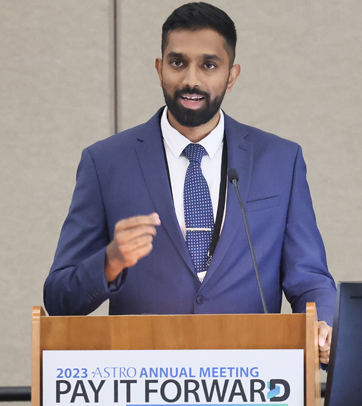


By James B. Yu MD, MHS, FASTRO, Connecticut Radiation Oncology
The PACE-B study was a landmark study published in the Lancet Oncology in 2022 randomizing 874 men with prostate cancer between standard fractionation (78 Gy in 39 fractions or 62 Gy in 20 fractions) and SBRT (36.25 Gy in 5 fractions).1 The vast majority of patients had intermediate risk prostate cancer. The investigators reported two-year study results and found that two-year toxicity rates were similar, with grade 2 or worse RTOG genitourinary toxicity and gastrointestinal toxicity not significantly different between arms. At this year’s ASTRO meeting, Ragu Ratnakumaran, MBBS, and colleagues present an analysis comparing the toxicity seen in the acute post-treatment phase (within 12 weeks of treatment completion) and late phase (between 6-24 months after treatment) in ASTRO ABSTRACT 144, “The Association between Acute and Late Genitourinary and Gastrointestinal Toxicities: An Analysis of the PACE B Study.”
Prior investigators have done this type of analysis before, generally showing that acute toxicity does indeed predict late toxicity. For example, over a decade ago, Barbara Jereczek-Fossa, MD, PhD, showed that for patients treated with 3-D CRT in various doses and situations (postoperative and intact prostate cancer), acute toxicity was an independent predictor of late toxicity.2 Matthew Peach, MD, and colleagues went even further, performing a systematic review showing that late and acute gastrointestinal toxicities were correlated.3 Nonetheless, repeating this analysis in a modern and prospectively recruited and followed cohort is valuable, as treatment and technique continue to evolve. As well, to assess this relationship between acute and late toxicity in both standard and SBRT fractionation in the same study is valuable.
Dr. Ratnakumaran and colleagues found that acute and late CTCAE toxicity is indeed correlated. Specifically, Grade 2+ baseline GU, Grade 2+ acute GU and GI toxicity were all correlated with late toxicity after both SBRT and conventional radiation, even after adjusting for other covariates. The predictive models area under the curve (AUC) were modest, with values varying from 0.64 to 0.73, indicating reasonable but not fantastic discrimination. However, the effect size of baseline symptoms and the odds ratio for late toxicity were relatively high, particularly for genitourinary toxicity in univariate analysis, with baseline symptoms associated with late toxicity at an odds ratio of 7.59 (95% CI [2.72-21.19], p<0.0001) following SBRT and 7.98 (95% CI [3.03-20.96], p<0.0001) following conventional radiotherapy. SBRT and conventional radiation acute toxicity was associated with late toxicity at an odds ratio of 4.63 (95% CI [2.96-7.25, p<0.0001) and 2.83 (95% CI [1.69-4.71], p<0.0001.
Regarding the importance of this study, Dr. Ratnakumaran notes, “This analysis shows that acute toxicity can be used as a predictor of late toxicity in future clinical trials. Additionally, baseline GU symptoms are associated with higher rates of late toxicity, meaning patients can be better selected and counselled regarding their individual risk and preferred fractionation.”
The authors conclude that knowing that baseline symptoms and acute toxicity is strongly associated with late toxicity presents an opportunity to intervene. Specifically, “early medication use/surgical intervention of those with baseline urinary symptoms or acute toxicities. However further studies are required to test if these interventions could mitigate the development of late toxicity.”
Future work will “assess specific dosimetric factors which predict for late toxicity after SBRT and suggest new dose constraints which could mitigate late toxicity.”
References
Abstract 144 - The Association between Acute and Late Genitourinary and Gastrointestinal Toxicities: An Analysis of the PACE B Study was presented on October 2, 2023, during the SS 08: GU 2: Clinical Trials in Prostate Cancer session at the 2023 ASTRO Annual Meeting.